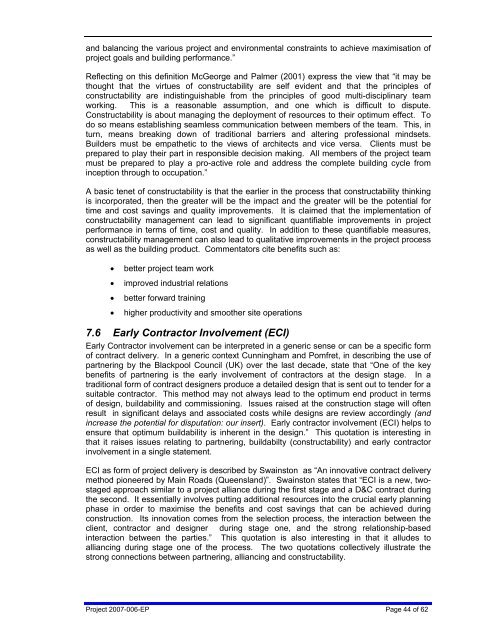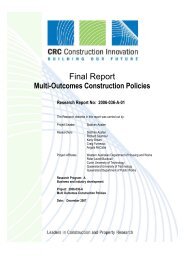Dispute Avoidance and Resolution (literature review) - Construction ...
Dispute Avoidance and Resolution (literature review) - Construction ...
Dispute Avoidance and Resolution (literature review) - Construction ...
You also want an ePaper? Increase the reach of your titles
YUMPU automatically turns print PDFs into web optimized ePapers that Google loves.
<strong>and</strong> balancing the various project <strong>and</strong> environmental constraints to achieve maximisation ofproject goals <strong>and</strong> building performance.”Reflecting on this definition McGeorge <strong>and</strong> Palmer (2001) express the view that “it may bethought that the virtues of constructability are self evident <strong>and</strong> that the principles ofconstructability are indistinguishable from the principles of good multi-disciplinary teamworking. This is a reasonable assumption, <strong>and</strong> one which is difficult to dispute.Constructability is about managing the deployment of resources to their optimum effect. Todo so means establishing seamless communication between members of the team. This, inturn, means breaking down of traditional barriers <strong>and</strong> altering professional mindsets.Builders must be empathetic to the views of architects <strong>and</strong> vice versa. Clients must beprepared to play their part in responsible decision making. All members of the project teammust be prepared to play a pro-active role <strong>and</strong> address the complete building cycle frominception through to occupation.”A basic tenet of constructability is that the earlier in the process that constructability thinkingis incorporated, then the greater will be the impact <strong>and</strong> the greater will be the potential fortime <strong>and</strong> cost savings <strong>and</strong> quality improvements. It is claimed that the implementation ofconstructability management can lead to significant quantifiable improvements in projectperformance in terms of time, cost <strong>and</strong> quality. In addition to these quantifiable measures,constructability management can also lead to qualitative improvements in the project processas well as the building product. Commentators cite benefits such as:• better project team work• improved industrial relations• better forward training• higher productivity <strong>and</strong> smoother site operations7.6 Early Contractor Involvement (ECI)Early Contractor involvement can be interpreted in a generic sense or can be a specific formof contract delivery. In a generic context Cunningham <strong>and</strong> Pomfret, in describing the use ofpartnering by the Blackpool Council (UK) over the last decade, state that “One of the keybenefits of partnering is the early involvement of contractors at the design stage. In atraditional form of contract designers produce a detailed design that is sent out to tender for asuitable contractor. This method may not always lead to the optimum end product in termsof design, buildability <strong>and</strong> commissioning. Issues raised at the construction stage will oftenresult in significant delays <strong>and</strong> associated costs while designs are <strong>review</strong> accordingly (<strong>and</strong>increase the potential for disputation: our insert). Early contractor involvement (ECI) helps toensure that optimum buildability is inherent in the design.” This quotation is interesting inthat it raises issues relating to partnering, buildabilty (constructability) <strong>and</strong> early contractorinvolvement in a single statement.ECI as form of project delivery is described by Swainston as “An innovative contract deliverymethod pioneered by Main Roads (Queensl<strong>and</strong>)”. Swainston states that “ECI is a new, twostagedapproach similar to a project alliance during the first stage <strong>and</strong> a D&C contract duringthe second. It essentially involves putting additional resources into the crucial early planningphase in order to maximise the benefits <strong>and</strong> cost savings that can be achieved duringconstruction. Its innovation comes from the selection process, the interaction between theclient, contractor <strong>and</strong> designer during stage one, <strong>and</strong> the strong relationship-basedinteraction between the parties.” This quotation is also interesting in that it alludes toalliancing during stage one of the process. The two quotations collectively illustrate thestrong connections between partnering, alliancing <strong>and</strong> constructability.Project 2007-006-EP Page 44 of 62
















